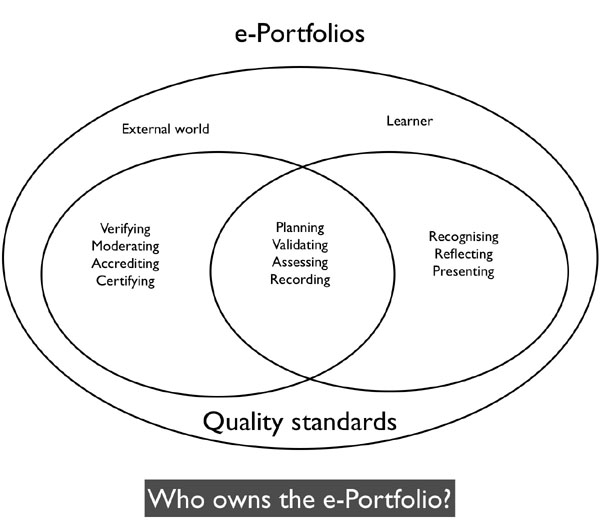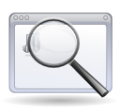 Digg this
Digg this
 Post to del.icio.us
Post to del.icio.us
 Post to Furl
Post to Furl
 Post to Magnolia
Post to Magnolia
 Post to Yahoo
Post to Yahoo
Session 1: Introduction to ePortfolios [75 minutes]
Objectives
|
after this session the participant will be able to :
Alternative:
- Show examples of „good” e-portfolios
- Explain the difference between e-portfolio and paper portfolio and personal website)
- Identify reasons for e-portfolio creation
- describe the ePortfolio process
|
Outcomes
- Designing criteria for evaluating portfolio
- Evaluate specific example of e-portfolio (why is it good/bad?)
- List of the ideas on how e-portfolio can help you (personal gains from using e-portfolio)
- List of the elements of e-portfolio
- A very basic structure of personal EP
ACTIVITIES -> INPUT
- watch videos -> idea on what e-portfolios are, how and why they are used
- explore samples (not just EPs, but also portfolios and personal webpages) -> the structure, elements and content of EP; the difference between EP and other stuff
- create evaluation criteria and evaluate them -> what are the characteristics of „good” e-portfolio
- prepare a very basic structure of one's own e-portfolio -> what and why will be done (basic idea)
|
Activites
Activity
| Session 1 - Activity 1 - ePortfolios, what are they? - why should our learners have them? [30 minutes]
To introduce this module we have four short videos.
- What are ePortfolios? Their role in 21st century learning - Serge Ravet, Eifel
- e-Portfolio implementation and development - Graham Atwell, Pontydysgu
- A student's ePortfolio story Thomas Pallister - Wolsingham School and Community College
- A teacher's ePortfolio story: Implementing a Multimedia Student ePortfolio John Pallister, Wolsingham School and Community College
Note to teacher and learners
- If you are following this course by self learning you may wish to watch all of the videos.
- If you are a facilitator or teacher delivering this course in a face to face situation you may wish to select one or more of the videos depending on the needs and experience of your participants. You also may wish to download and edit the slides used here to make your own presentation. All materials are freely available and we have attempted to ensure everything can be reused and re-edited whenever possible.
Activity
ePortfolios could be defined as “a purposeful collection of student [or teacher] work that illustrates efforts, progress, and achievement in one or more areas over time. An electronic portfolio uses digital technologies, allowing the portfolio developer to collect and organize portfolio artifacts in many media types (audio, video, graphics, text). A standards-based portfolio uses a database or hypertext links to clearly show the relationship between standards or goals, artifacts, and reflections. The learner's reflections are the rationale that specific artifacts are evidence of achieving the stated standards or goals. An electronic portfolio is a reflective tool that demonstrates growth over time."
(Barrett, 2004)
There are three broad approaches to ePortfolio development and use.
- What would be the issues that you would need to address if you were to in introducing an ePortfolio for your learners or institution?
- List these on a flip chart or in a wiki.
|
Activity
| Session 1 - Activity 2 - exploring the potential of a range of sample ePortfolios [30 minutes]
Task: Explore these sample ePortfolios
- ANYONE ABLE TO HELP US WITH SUPPLY OF SAMPLE DE-PERSONALISED ePORTFOLIOS?
Helen Barret has developed a number of examples of e-Portfolios using different systems on her web site.
- OFFLINE page copies stored in PDF format and linked to wiki HERE - ANYONE ABLE TO HELP WITH EXAMPLES??
Task: Feedback or Record what you have found out by looking at the ePortfolios.
- are their any common elememts or features?
- what are the differences between the Online and Offline ePortfolios?
Task: Design your own evaluation criteria for what makes a good ePortfolio. Your evaluation criteria should include:
- ease of use, how easy is it for the user to find the required evidence?
- what evidence is stored in them, what evidence is stored?
- is the evidence stored appropriate, does the evidence stored show or demonstrate what it says it does?
- possible applications, what could they be used for?
Task: Use your evaluation criteria to rate each of the ePortfolios:
|
Activity
| Session 1 - Activity 3 - ePortfolios, the process [15 minutes]
Task: Think about what the stages that your learners go through when they are working on any coursework or portfolio work. Now think about what stages your learners would need to go through if they were using an ePortfolio to help them. They would:
- identify what they need to learn
- review evidence that they have already stored
- identify the evidence that they need to demostrate their competenceor learning
- think about when they might be able to collect the evidence that they need
- think about how, and what would be the most appropriate methods that they would need to use to capture and record the required evidence
- design anaction plan that details what it is that they will need to do or organise that will provide them with the evidence generating opportunities that they need. The plan will also identify how and when they are going to capture the evidence.
- do whatever they need to do and make sure that the evidence is recorded
- link the new evidence into the ePortfolio in such a way that it can be to retrieved and presented efficiently
- reflect on their learning and achievements
START THE CYCLE again
Task: Watch this Presentation: : the ePortfolio Process pdf Format
Discuss or record these questions:
- What are the different processes involved in developing an ePortfolio?
- how do these processes compare with those normally followed by your learners who do not use ePortfolios?
ePortfolio Process Diagram

Watch this short presentation Presentation: portfolio processes Presentation by Graham Attwell.
- do you agree with his definition of portfolio processes. If not, why?
- have any processes been missed out?
- Has he included processes you think should not be part of the ePortfolio development process?
|
Resources
![]() Digg this
Digg this
![]() Post to del.icio.us
Post to del.icio.us
![]() Post to Furl
Post to Furl
![]() Post to Magnolia
Post to Magnolia
![]() Post to Yahoo
Post to Yahoo


